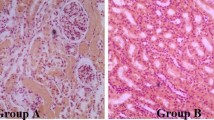Summary
The existence of tissue-bound lithocholate in liver tissue was first suggested by Nair et al. (Lipids 1988;12:922–929). Since lithocholate is well known to be cholestatic, we investigated whether tissue-bound lithocholate, if present, can be correlated to liver dysfunction in obstructive jaundice. Tissue-bound lithocholate in liver tissues of 7 patients with obstructive jaundice was analyzed using gas chromatography-mass spectrometry-selected ion monitoring. We found no accumulation of lithocholate, including tissue-bound form, indicating that the role of lithocholate in inducing hapatic dysfunction in obstructive jaundice is minimal, if any.
Similar content being viewed by others
References
Fisher MM, Magnusson R, Miyai K: Bile acid metabolism in mammals. I.Bile acid induced intrahepatic cholestasis. Lab Invest 1971;25: 88–91
Miyai K, Richardson AL, Mayer W, et al: subcellular pathway of rat liver in cholestasis and choleresis induced by bile salts. (1) Effects of lithocholic, 3β-hydroxy-5-cholenoic, cholic and dehydrocholic acids. Lab Invest 1977;36: 249–258
Kakis G, Yousef IM: Mechanism of cholic acid protection in lithocholate-induced intrahepatic cholestasis in rats. Gastroenterology 1980;78: 1402–1411
Mathis U, Karlaganis G, Preisig R: Monohydroxy bile salt sulfates: Tauro-3β-hydroxy-5-cholenoate-3-sulfate induces intrahepatic cholestasis in rats. Gastroenterology 1983;85: 674–681
Oelberg DG, Chari MV, Little JM, et al: Lithocholate glucuronide is a cholestatic agent. J Clin Invest 1984;73: 1507–1514
Nair PP, Mendeloff AI, Vocci M, et al: Lithocholic acid in human liver:identification of ε-lithocholyl lysine in tissue protein. Lipids 1977;12: 922–929
Nair PP, Solomon, R, Bankoski J, et al: Bile acids in tissues: binding of lithocholic acid to protein. Lipids 1978; 13: 966–970
Turjiman N, Nair PP: Nature of tissue bound lithocholic acid and its implication in the role of bile acids in carcinogenesis. Cancer Res 1981;41: 3761–3763
Yanagisawa J, Akashi Y, Miyazaki H, et al: Critical evaluation of the existence of so-called tissue-bound lithocholate in human liver tissue by selected ion monitoring. J Lipid Res 1984;25: 1263–1271
Yanagisawa J, Itoh M, Ishibashi M, et al: Microanalysis of bile acid in human liver tissue by selected ion monitoring. Anal Biochem 1980;104: 75–86
Schaffner F, Popper H: Structure of the liver. In: Berk JE et al eds. Bockus Gastroenterology 5th ed. W.B.Sanders Company, Philadelphia. 1985;2626
Akashi Y, Miyazaki H, Nakayama F: Correlation of bile acid composition between liver tissue and bile. Clin Chim Acta 1983;133: 125–132
Author information
Authors and Affiliations
Rights and permissions
About this article
Cite this article
Yanagisawa, J., Nagai, M., Hirano, Y. et al. Lithocholate in liver tissue with obstructive jaundice. Gastroenterol Jpn 24, 156–158 (1989). https://doi.org/10.1007/BF02774190
Received:
Accepted:
Issue Date:
DOI: https://doi.org/10.1007/BF02774190




